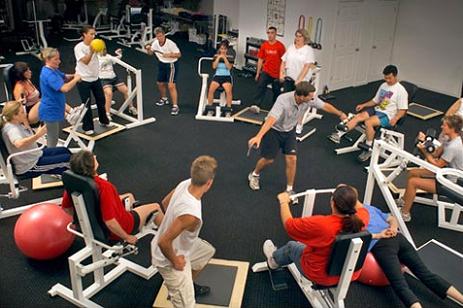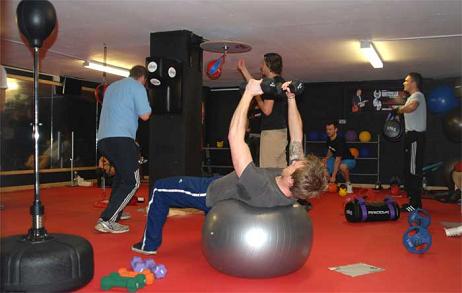Today I would like to examine the physiological benefits of circuit training. There are many forms of circuit training, from machine-based static circuits, to boot camp style workouts and even kickboxing workouts. But what is circuit training and how can we put it to the best possible use?
Many gyms offer standard cookie-cutter circuit training programs, which are sometimes prescribed by the in-house personal trainer and recommended by other lazy staff members. The circuit is set up in some back room with a timer alarm to tell you when to move to the next station. Should you use this system or put together your own free weight circuit or join a boot camp?
What does circuit training actually offer you?
What are the physiological benefits and who is best suited to participate in circuit training?

There are several theoretical benefits of circuit training that are disseminated online.
I found some of the following claims of the alleged benefits of circuit training:
- Maximum results in a minimal amount of time.
- Circuit training combines toning, cardiovascular fitness, and resistance training in one time-efficient workout.
- Cardiovascular benefits are limited when circuit training includes only resistance training.
- Circuit training offers one workout that can improve strength, burn fat, and increase aerobic fitness.
- Clients can achieve a systemic aerobic effect from anaerobic resistance training.
- The quick pace of circuit training is optimal for fat burning.
At least resource #3 got it right, but that definition comes from Indiana University while the rest of those resources are from your basic foo-foo fitness websites and personal trainers.
The constant in circuit training is this: the client should progress from one exercise to the next with minimal rest for the duration of the training session.
These are the variables in circuit training:
- exercises
- sets
- reps
- intensity
- equipment
- rest periods
- duration
Changing any of those variables effectively changes the stimulus and benefits of the workout.
What we Already Know About the Physiology of Exercise
We have the following scientific facts about exercise physiology that we should look at when analyzing circuit training:
- Anaerobic adoptions are facilitated by an overload stimulus.
- Aerobic adoptions are facilitated by repetitive steady-state aerobic exercise.
- Aerobic exercise and anaerobic exercise cause different adaptations.
- Cardiovascular benefits can be had by both anaerobic and aerobic exercise.
- Cardiovascular exercise and aerobic exercise are not the same things.
- During exercise, larger muscle groups require a higher cardiovascular demand. Therefore anaerobic exercise can prompt cardiovascular benefits, but only aerobic exercise forces aerobic adaptation. This does not mean we can’t train with movements commonly associated with anaerobic exercise to elicit an aerobic adaptation.
- True fat burning occurs by exercising aerobically at a steady state so that the heart rate can maintain a specific percentage of the target heart rate.
- When any of the training variables are changed, the body elicits different adaptations to the new stimulus.
How to Design a Circuit Training Program
Suppose you still want to design a circuit for one of your clients. How would you do that?
First, we should analyze what determines the effectiveness and outcome of a circuit-training program.
Some questions you should ask when designing a circuit:
- What are the client’s intended goals? (strength, fat loss, power, endurance, health, etc…)
- Is the client restricted by injury or health problems?
- What kind of intensity is required to meet the client’s goals?
- Are we looking to force a specific adaptation or just to exercise at a steady-state?
- Which type of muscle fibers are we looking to recruit?
Managing Energy Systems
If possible, we need to determine which energy system to target in order to force adaptations that will facilitate the client’s goals. The exercise program will target certain muscle fibers by stressing a particular energy system.
Intensity is the main factor that we will use to determine whether to use the aerobic or anaerobic energy system.
To review:
- The anaerobic energy system will use a limited supply of Adenosine Tri-phosphate (ATP), phospho-creatine, carbohydrates, and protein when necessary to derive energy. The anaerobic energy system is used for high intensity, short-duration activity where we can expect a maximal effort or shorts bursts of strength. Here, we focus on type IIb, fast-twitch, anaerobic, glycolytic, white muscle fibers that contain only sparse amounts of mitochondria and myoglobin.
- The aerobic energy system uses carbohydrates and fats for energy and is mainly used for the steady-state activity, which includes simply being at rest. We must be able to maintain a steady oxygen concentration in the working muscles for this. Here we focus on type I short twitch fibers. Here, we focus on type I, slow-twitch, aerobic, slow oxidative, red muscle fibers, which are full of capillaries and rich in mitochondria and myoglobin.

Here is a real-world example:
In this example, we are trying to promote strength and muscle gains by including resistance training machines in the circuit.
Suppose we are performing a seated shoulder press (a common exercise in circuit training). We can choose to perform the exercise for a constant X number of reps regardless of intensity, or we can choose to rep until muscular failure before moving on to the next exercise.
In the case of working towards a constant X number of reps, we see that the intensity is not high enough to recruit enough fast-twitch muscle fibers to force an anaerobic adaptation, nor are we focusing on the steady-state aerobic exercise that would cause anaerobic adaptation. Instead, all we can hope to achieve is to burn some calories.
In the case of performing an exercise to muscular failure, we do engage the anaerobic energy system enough to encourage an adaptation, but in completing a full circuit we will surely find that our body can’t replenish ATP fast enough to be able to reach optimal muscular failure on each consecutive exercise (full replenishment takes a full 3 minutes on average). In this case, we will see a decreasing return on energy invested. There is also no aerobic benefit to this protocol.
Here is another real-world example:
In this example, we include cardiovascular exercise in order to promote aerobic adaptation, but not necessarily fat loss.
Suppose we are using the treadmill for walking, jogging, and running. We can choose to walk or jog at a steady state for a constant X number of minutes, or we can choose to increase the intensity for 2 minutes for every 4 minutes of exercise in an attempt to imitate the HIIT training protocol.
In the case of working in a steady-state, you will be able to encourage aerobic adaptation, but this is not circuit training, it is just plain cardio. True circuit training would have the client moving to various cardiovascular machines such as the stair master, elliptical, treadmill, rowing machine, etc… This would most likely provide the aerobic adaptations that the client is looking for, but would in NO way be conducive to muscle growth, which is a vital component of increasing metabolism – a short term and long term goal of any fat loss program. The anaerobic energy system does not apply in this case.
In the case of training in high-intensity intervals, this is an excellent way to build muscle while burning calories, increasing aerobic capacity, and increasing metabolism. Once again though, this is not circuit training – this is HIIT training and involves the anaerobic energy system. This protocol could be implemented by prescribing a series of machines used at full intensity, alternating in combination with a series of plyometric or cardiovascular exercises (such as burpees or squat jumps), which would be used as the rest interval, but again this is NOT conducive to the steady-state needed to facilitate the client’s goals of aerobic adaptation.
Learning From The Examples
As you can see with either of the above examples, we can focus on building muscle, strength gains, burning fat, or burning calories with circuit training, as long as we optimize all of the circuit training variables for each specific goal. But if you noticed, there is always a better solution to forcing the required adaptations, be it anaerobic weight lifting, HIIT, or long-distance steady-state endurance cardio.
For fat burning, we need to get to that steady state in order to specifically use fats as a fuel source. An individual can get to that steady state in roughly 3-4 minutes, but for aerobic adaptations to occur the steady-state should be maintained for at least 20 minutes. Moving from station to station cause a variation of intensity and duration, and will often result in sub-optimal use of the anaerobic energy system, causing little or no adaptation for either energy system. Fat burning, in this case, becomes highly unlikely.
So, What Is Circuit Training Really Good For?
We can draw several conclusions from the analysis of groups of individuals who have participated in studies involving prescribed circuit training for a prolonged period of time.
This is what we know about circuits:
- Circuit training is not optimal for increasing cardiovascular fitness when compared to High Intensity Interval Training (HIIT)
- Circuit training is not optimal for increasing cardiovascular fitness when compared to cardiovascular training when the heart rate is at the target heart rate (THR) calculate your target heart rate
- Circuit training is not optimal for forcing anaerobic adaptation when compared to a strength training program
- Circuit training is not optimal for forcing aerobic adaptation when compared to an aerobic training program
- Circuit training is not optimal for increasing muscle size when compared to a hypertrophy-based training program
- Circuit training is not optimal for increasing strength when compared to HIIT or a regular resistance training program
- Circuit training is useful for burning additional calories and stimulating blood flow to the limbs
- Circuit training is useful for squeezing lots of exercise into a short time frame
Who Can Benefit From Circuit Training

In light of everything you just read, can anyone actually benefit from circuit training? The answer is yes, but obviously the benefits are not optimal for experienced athletes. Subgroups of trainees such as the elderly, young, rehabbing, novice, or obese athletes might do well circuit training optimized in the following ways:
- Goal #1: maximal strength.
Clients looking to maximize anaerobic adaptations will have to use a circuit designed for high intensity, reaching a high level of fatigue on each exercise. Since there is a 3-minute threshold for complete ATP recovery, then a minimum of 2 minutes rest between sets is mandatory, or the required intensity and fatigue will not be generated for subsequent sets.
- Goal #2: increase stamina.
As is the case with an athlete who plays sports such as football, MMA, or hockey, which require maximal force output in an exhaustive state, minimal rest periods would likely be beneficial. By maximizing intensity while also minimizing rest periods, circuit training with resistance machines is likely to increase stamina – repeated maximal force output without recovery.
- Goal #3: burning calories and fat.
Since we are not able to burn fat unless we are working aerobically, most circuit training programs will not suffice unless each exercise is performed for a duration of at least 4 minutes. In this case, we can only hope to burn calories, and possibly a little fat, by moving rapidly to each exercise station and maintaining a steady rhythm. Ultimately the client will be exercising not at, but close to, the anaerobic threshold.
- Goal #4: fit as much exercise as possible in a limited time frame.
Circuits do allow you to complete a high volume workout in a short period of time. A client with a restricted time frame, who just wants to exercise for the sake of exercise, without any specific goals, could benefit from circuit training. Little anaerobic or aerobic adaptations will occur, but the client will be in better condition and better health for having exercised at all.
Please note that by asking the client questions and ultimately arriving at a particular goal, you as a personal trainer should be able to devise an optimal workout routine that will force energy system adaptations, which will hasten the client to his or her goal faster than generic circuit training.
Specific aerobic or anaerobic workout routines will work much better than most forms of optimized circuit training. Remember this when designing a workout routine for yourself or your clients. Think about these things before settling your client into a generic circuit training routine.
Tags: boot camp, circuit training, hiit











‘Circuit Training Girl’ is Bollywood actress Shilpa Shetty. She’s a workout-aholic!
What type of training methods do I need to employ to engage in auto-felatio? Sincerly, Wilbert Sumuel
First you will have to have your bottom 4 ribs removed, then you will need to have your head extracted from your rectum, where it clearly resides if you are leaving these kind of comments on my blog. For anyone who wishes to spam or bust on Wilbert for being a dink, please write to [email protected], which may or may not be his real email address, but if it is then clearly he is dumber than a spider monkey.
Excellent post. Very detailed. However, one point that I thought should have been mentioned, and I did not see it mentioned, was muscle confusion. Muscle confusion will stimulate muscle growth faster than regular reps, and should be what the focus of circuit training is. Intense muscle confusion is the essence of the “300” body.